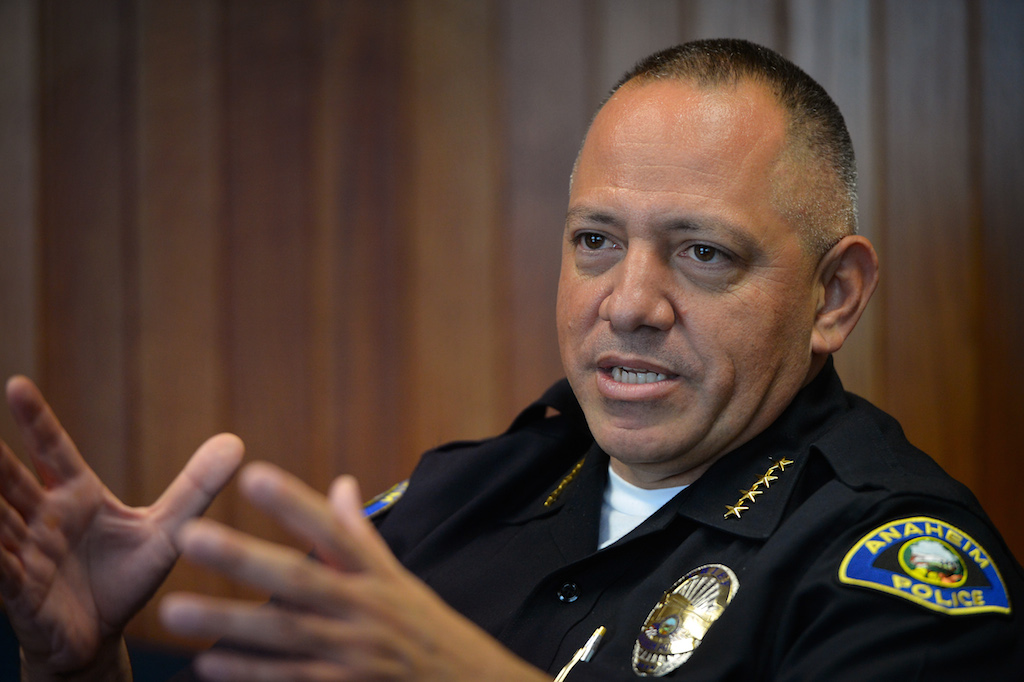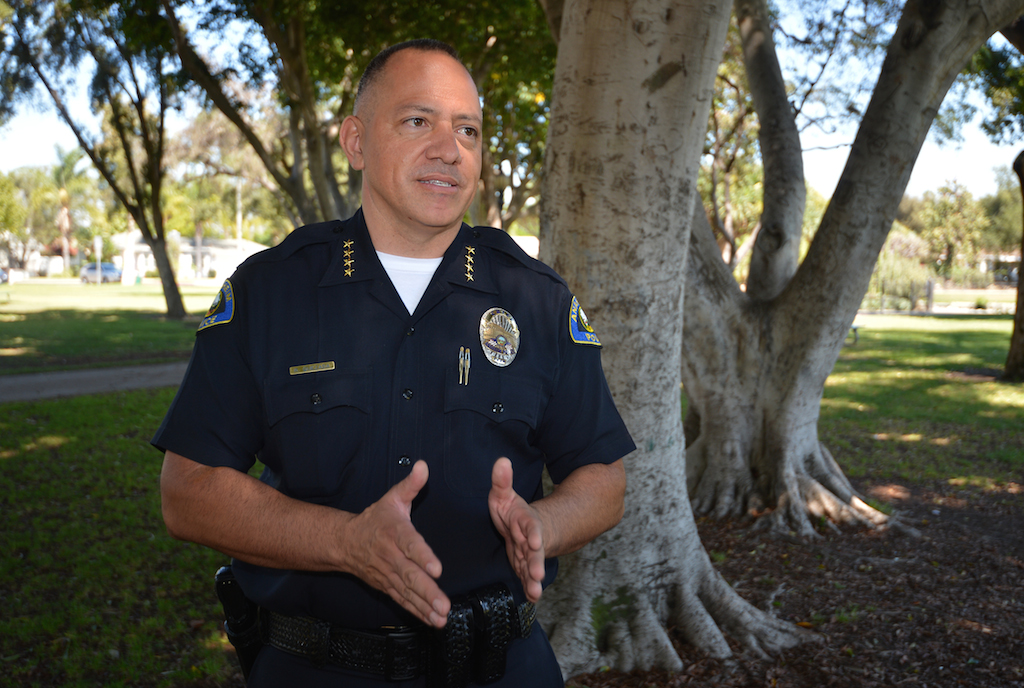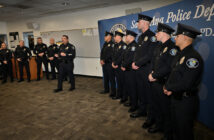Raul Quezada peels a small bandage off his right arm.
The Anaheim police chief didn’t hurt himself. Rather, he just donated blood.
The removal of the Band-Aid is an apt metaphor for what Quezada has been doing since being named top cop of Orange County’s largest city on Dec. 17, 2013: tearing away barriers between his department and the community.
Back-to-back officer-involved shootings in 2012 sparked unrest in working-class Latino neighborhoods that culminated in a downtown riot.
In repair mode, Quezada – who served as interim police chief for six months before becoming the first Latino police chief in Anaheim’s history, as well as one of its youngest, at age 44 — has been taking steps to improve communication with the public and make his agency as transparent as possible.
These efforts resulted in a milestone on Sept. 9 when the Anaheim City Council agreed to purchase 250 video cameras for $1.15 million to be worn by the city’s 374 sworn police officers. A yearlong study of body-worn cameras by the Rialto Police Department showed that cameras result in a dramatic drop in use-of-force incidents and fewer complaints from the public.
“We recognize that (cameras) are the future of policing,” Quezada says. “Our officers have been asking for them.”
Anaheim, home to more than 336,000 residents and major tourist attractions including the Disneyland Resort, is the first city in Orange County to require its officers to capture their encounters with the public on camera, although a handful of other agencies are testing them.
For the last 1½ years, Anaheim PD officers have been using audio recorders.
“The community demands transparency,” says Quezada, who took an unlikely path to becoming police chief of one of America’s largest cities. Quezada is the son of immigrant parents from Mexico who toiled in the fields and a cannery in Northern California before settling in East Los Angeles to raise a family.
Quezada and his three older sisters grew up in the rough neighborhood of Rio Honda in Pico Rivera, a “gateway” city to Los Angeles that has long been home to Latino street gangs.
Quezada recalls working as an aide at a recreation center when he was 14. He frequently would run across heroin addicts shooting up in the public restroom.
“I would lock them inside the bathroom to keep kids from coming in,” Quezada recalls.
While in the fifth and sixth grade, Quezada would look around his classroom at times and notice some empty seats.
“Some of the kids would just vanish,” he says.
As police chief of Anaheim, Quezada is determined to reduce the risk of such disappearing acts by getting his officers and residents to work more closely together to make the city safer.
Quezada aims to make the Anaheim PD a nationwide leader in the “Problem Oriented Policing” approach to crime and public disorder by forging partnerships with residents and business owners who, in turn, promise to throw their support behind specific problem-solving efforts.
“The key is listening to the community to determine what their problems are instead of having us tell them what their problems are,” says Quezada, who joined the Anaheim PD in 1996 after spending three years with the Los Angeles PD.
Examples of how the Anaheim PD, under Quezada’s leadership, has been making strides in improving dialogue with the city’s communities include:
* Supplementing his Chief’s Advisory Board with a grassroots group of residents from each of the city’s 22 neighborhoods. Called the Chief’s Neighborhood Advisory Council, or CNAC, the first meeting was held in November 2013, with more than 20 members of the community participating. “We challenged them to come up with ideas to improve communication between our officers and their communities,” Quezada says. “My message to them was, ‘We are one city, and one police department.’”
* Launching a mobile version of the PACE (Public Awareness through Citizen Education) citizen police academy. “It was a huge success,” says Quezada of bringing the program to Spanish-speaking neighborhoods. “A lot of the education was missing as to how and why we operate the way we do. What does the community want? It wants the police. Many residents just don’t know what the police department is about. They think we just drive by in a black-and-white, handle emergency calls and then leave. To go out and spend five minutes explaining our role to them was huge.”
* Continuing to expand programs aimed at young people. During the summer, more than 1,000 people packed an Anaheim Convention Center hall as 414 kids graduated from the police department’s Jr. Cadet program, the only-of-its-kind program in California. The program builds relationships with 9-12 year olds by teaching lessons in respect and discipline and also – hopefully – inspires some to pursue careers in policing. The police department hopes to recruit more homegrown officers.
Quezada says he also sought input from members of the community regarding the promotion of a lieutenant, which is unusual for such a high-ranking position.
He also has taken steps to improve the way officer-involved shootings are handled.
For example, an Anaheim PD lieutenant now issues a report on any shooting incident within five days to get a quick snapshot of what happened, instead of waiting for the district attorney to complete an investigation, which can take several months. And after any officer-involved shooting, a high-ranking police official immediately reaches out to relatives of the suspect, Quezada says.
The city has also established a civilian public safety review board. Set to meet for the first time this fall, the Public Safety Review Board will review items such as fire and police budgets, staffing levels, service delivery mechanisms, police and fire policies and practices, and certain critical incidents.
Quezada says the recent officer-involved shooting in Ferguson, Mo. underscores the importance of police departments establishing close ties with members of the community before problems erupt.
After the civil unrest in 2012, the Anaheim PD made an effort to meet with disgruntled members of the community in an effort to prevent flare-ups around the anniversaries of the incidents.
Such outreach paid off, Quezada says, with organized protests in 2013 and 2014 going off smoothly.
“We let them have the street,” the chief says of the most recent protest. “We met with the organizers, asked them the direction of their route, had a captain give them his cell phone number, and told them we would have paramedics on standby in case there were any heat-related or other health issues with the protesters.
“The key is to communicate. You have to communicate,” he says.
Efforts by Quezada and his command staff appear to be paying off. Out of 200,000 calls for service received by the police department last year, the PD received only 30 complaints from the public — fewer than the number of complaints made from inside the department.
“This shows we’re doing a good job at self-policing,” Quezada says.
They are also doing an innovative job in traditional policing. Several Orange County police agencies recently created a regional task force to deal with the growing problem of human trafficking. The program was inspired by Anaheim, which was the first to treat sex workers as victims.
The police department also recently formed a homeless outreach detail that is becoming a model.
Married with three children, Quezada briefly sold insurance before getting into law enforcement. His background in parks and recreation helped fuel his philosophy of community policing.
A graduate of the Sherman Block Leadership Institute and P.O.S.T Command College, Quezada currently is enrolled in the Master of Science in Criminal Justice Administration program at Columbia Southern University.
The police chief may be all about serving the local community, but he’s still a die-hard Dodgers fan.
Among the baseball memorabilia in his office is a Dodgers jersey with Quezada’s name in lettering on the back and a signed portrait of former Dodgers manager Tommy Lasorda.
“You and the Dodgers are great,” Lasorda wrote.
Quezada is quick to add about Anaheim’s home team: “So are the Angels.”
 Behind the Badge
Behind the Badge






